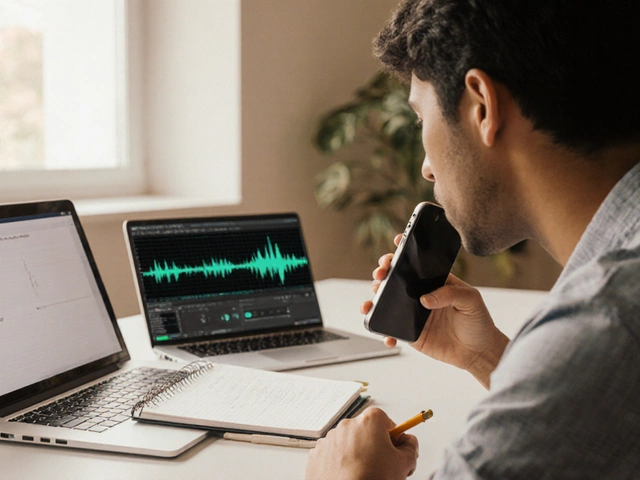Fluency Rate & Filler Word Tracker
Measure Your Speaking Progress
Track your fluency metrics to see your improvement over time. Based on recommendations from the article.
Ever felt tongue‑tied when you try to speak English? You’re not alone. Millions of learners hit the same wall, but the good news is that fluency isn’t a talent you’re born with - it’s a skill you can train. Below is a step‑by‑step roadmap that turns hesitant speech into confident conversation.
What "fluent English speaking" actually means
Fluent English Speaking is the ability to express ideas clearly, naturally, and without frequent pauses or grammatical stumbling, while being understood by native speakers. It combines three core components: pronunciation that sounds authentic, vocabulary that fits the context, and the confidence to keep the dialogue flowing.
Set a realistic baseline
Before you launch into intense practice, take a quick self‑assessment. Record a two‑minute monologue about your day, then listen back. Notice three things: (1) how many “uh‑uh” filler words you use, (2) any mispronounced sounds, and (3) whether you can convey the main idea without pausing. This baseline becomes your benchmark for progress.
Build a strong phonetic foundation
Pronunciation is the gateway to being understood. Focus on these high‑impact areas:
- Pronunciation - practice minimal pairs like “ship/sheep” and “bat/bet”. Apps such as Elsa Speak give instant feedback on vowel length and stress.
- Accent Reduction - watch videos of native speakers from the region you want to emulate (e.g., British RP, American Midwest). Mimic the intonation patterns for 10 minutes daily.
- Connected Speech - English rarely sounds like isolated words. Train yourself to link sounds ("gonna", "wanna", "lemme") by shadowing podcasts.
Expand functional vocabulary
Knowing 10,000 words won’t help if you can’t pull the right phrase at the right moment. Adopt a "chunk"‑based approach:
- Identify common collocations (e.g., "make a decision", "take responsibility").
- Create flashcards that show the phrase, a short definition, and an example sentence.
- Use each phrase in at least three personal sentences during a week.
Tools like Anki let you schedule spaced‑repetition reviews, ensuring the chunks stick.
Strengthen listening to boost speaking
Listening and speaking reinforce each other. Choose content just a notch above your current level - TED‑Ed talks, Netflix series with subtitles, or news podcasts. Follow this routine:
- Play a 2‑minute segment, pause, and transcribe exactly what you heard.
- Identify any unfamiliar words, look them up, and repeat the segment aloud.
- Shadow the speaker, matching rhythm and stress.
After a week, you’ll notice smoother delivery and fewer "uh" moments.
Practice speaking actively, not passively
Passive exposure (watching movies) is essential, but active practice is the game‑changer. Here are five proven methods:
| Method | Time Commitment | Feedback Type | Best For |
|---|---|---|---|
| Language Exchange (e.g., Tandem) | 30‑60 min/week | Peer correction | Real‑world conversation |
| Structured Speaking Course (e.g., Coursera English for Career Development) | 2‑3 hrs/week | Instructor feedback | Guided curriculum |
| Self‑Recording & Review | 10‑15 min/day | Self‑analysis | Self‑awareness |
| Impromptu Topic Cards | 5‑10 min/day | No external feedback | Thinking on your feet |
| Pronunciation Apps (e.g., ELSA) | 5‑10 min/day | AI‑driven scores | Fine‑tuning sounds |
Mix at least three of these methods each week. Consistency beats intensity - a daily 10‑minute chat is more valuable than a monthly marathon.

Leverage goal‑oriented resources
If you have a specific purpose-like preparing for IELTS or speaking at work-tailor your practice. For IELTS, focus on the "Part 2" cue card format: speak for two minutes on a given topic, then answer follow‑up questions. For business meetings, rehearse common phrases such as "Could you elaborate on that?" and "From my perspective...".
Track progress with measurable metrics
Numbers keep you honest. Record these weekly:
- Fluency rate - words spoken per minute (aim for 130‑150 wpm).
- Number of filler words per minute (target < 5).
- Pronunciation accuracy score from an app (goal > 85%).
- New collocations used in real conversations (track at least 5 per week).
When you see improvement, the motivation snowballs.
Overcome common roadblocks
Even with a solid plan, you’ll hit snags. Here’s how to bust them:
- Fear of mistakes - Reframe errors as data. Each slip tells you exactly what to fix.
- Plateau effect - Vary your input: switch from American news to British sitcoms, or from formal essays to street‑style rap lyrics.
- Limited speaking partners - Join online communities like Reddit’s r/Language_Exchange or attend virtual meet‑ups on Meetup.com.
Putting it all together: a 4‑week starter plan
Use the table below to schedule your first month. Adjust the times to match your lifestyle.
| Week | Focus Area | Daily Action | Weekly Check‑in |
|---|---|---|---|
| 1 | Pronunciation & Listening | 10 min shadowing + 5 min self‑recording | Compare recordings, note 3 improvement points |
| 2 | Vocabulary Chunks | Create 10 flashcards, use each in a sentence | Review flashcards, test recall rate |
| 3 | Speaking Practice | 30‑min language exchange + 5 min impromptu topics | Log filler words, aim for <5 per minute |
| 4 | Integration & Feedback | Take a mock IELTS speaking test or business role‑play | Score yourself, set next month’s goals |
By the end of the month you should notice smoother speech, richer word choice, and less anxiety.
Quick recap of the most effective habits
- Shadow native audio for 10 minutes daily.
- Record and review your voice at least once a day.
- Practice with a real partner weekly.
- Focus on high‑frequency collocations, not isolated words.
- Track measurable metrics and adjust your plan.
How long does it take to speak fluent English?
The timeline varies. With focused daily practice, many learners notice meaningful improvement in 3‑4 months, while reaching true fluency can take 1‑2 years depending on prior exposure and consistency.
Do I need a formal English course to become fluent?
Not absolutely. Self‑guided practice combined with occasional feedback (a tutor, language exchange, or AI app) can be just as effective, especially if you follow a structured plan.
What’s the best way to reduce my accent?
Focus on the three pillars: (1) listen to native rhythm, (2) practice minimal pairs, and (3) get real‑time feedback from pronunciation apps or a coach.
How much should I speak each day?
Even 10‑15 minutes of focused speaking (record‑review‑repeat) beats occasional hour‑long sessions. Consistency builds the neural pathways needed for fluency.
Can watching movies replace speaking practice?
Movies improve listening and vocabulary, but without active speaking you won’t develop the muscle memory needed for fluent output. Pair watching with shadowing or speaking drills.


